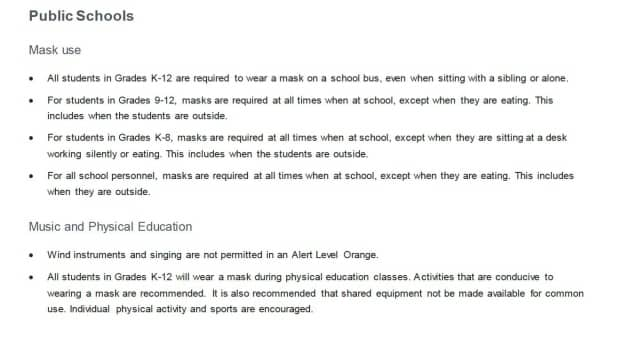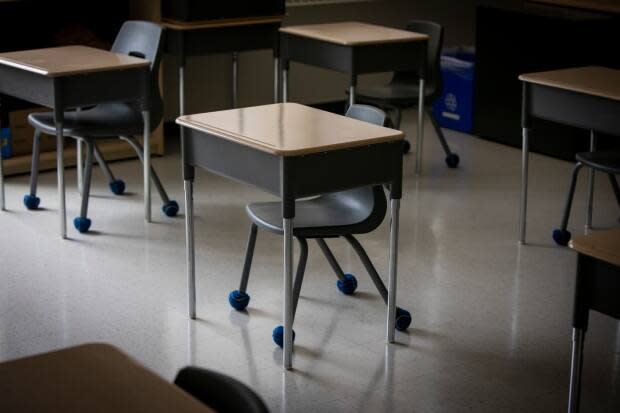N.B. COVID-19 roundup: no new cases today
For the first time since Oct. 4, there are no new COVID-19 cases in New Brunswick.
With one person recovered, the number of active cases dropped to 89 today. Five people remain in hospital, one in intensive care.
"Although we have no new cases today, we must remember that this virus is still present in New Brunswick and we need to be very cautious," said Dr. Jennifer Russell, the province's chief medical officer of health, in a news release.
"Self-isolation is our best tool in shortening the duration of these outbreaks. We need to maintain physical distancing, practise good hygiene and support each other as we work our way through this pandemic together."
The number of confirmed cases in New Brunswick is 292 and 201 have recovered. There have been two deaths, and the number of active cases is 89. As of today, 88,712 tests have been conducted.
Schools reopen
Schools in Campbellton and Dalhousie are open Thursday after confirmed cases of COVID-19 kept some closed earlier this week.
Students will return to classes at Sugarloaf Senior High School, Campbellton Middle School and Lord Beaverbrook School in Campbellton.
Classes were cancelled at the high school Friday after Public Health confirmed there was a positive case. The other two schools in Campbellton closed after parents and guardians were told there had been a possible exposure to the virus.
High school students from Listuguj First Nation will begin their online learning at the community's training centre now known as the Listuguj Learning Hub.
As a result of the government's decision to suspend the mini-bubble with Quebec's Avignon region — which allowed non-essential day trips by residents of Listuguj First Nation and Pointe-à-la-Croix into New Brunswick — about 103 students who attended Sugarloaf Senior High School and three students who attend the French high school will take part in full-time remote learning.
Extra week off
In Dalhousie, where all four schools had confirmed cases of COVID-19, students in Grades 9 to 12 at the Dalhousie Regional High School will return to class but students in Grades 6 to 8 will remain at home for another week and return to class on Oct. 23. The middle school students will do virtual learning.
The students at L.E.Reinsborough School will resume classes as well on Thursday, but parents have been advised the school cafeteria is not open.
Aux-Quatre-Vents high school did not close. Elementary students at Académie Notre-Dame are currently learning from home but will resume in class learning on Monday on a staggered schedule.
On Wednesday, Public Health officials warned parents about possible exposures at École François-Xavier-Daigle in Allardville, École Place-des-Jeunes in Bathurst, and École communautaire Carrefour Étudiant in Beresford.
Those schools remain open.
Attendance low at some orange-level schools
Some schools in the orange zones have noticed a drop in attendance.
Officials from Bonar Law school posted on Facebook that 27 per cent of students were missing on Tuesday and Wednesday.
The post reminds parents that schools are still open and that "every day that your child misses, they are getting further and further behind.
"For every day missed, it is actually two in most cases, because the teacher gives the offsite work to students on the day they are onsite."
It goes on to say that asking for home-learning options "is not a simple request and therefore cannot be fulfilled."
After listing all of the safety protocols in place to keep students safe, the post ends with, "Everyday really does count and we need to see our students if they are to succeed."

In a letter to parents, the principal of Bernice MacNaughton High also noted a decrease in attendance.
"This is reflective of the volume of phone calls and emails we have received from parents/guardians concerned about sending their child to school during this orange phase," said Martin Daigle.
He, too, said teachers are not equipped to support full-time learning at home.
"The guidelines provided by the Department of Education allow us to support distance learning for our most vulnerable students who have provided medical documentation of their underlying condition."
Masks in schools during orange phase
Students and staff attending schools located in health regions under the province's orange phase must wear masks more than those in schools that remain under the yellow phase.
Students must wear a mask on the school bus even when sitting alone.

High school students must wear masks at all times, including when they are outside, except when eating.
Students in kindergarten to Grade 8 also have to wear a mask at all times except when eating or when sitting at their desk working silently. The masks must also be worn outside.
All school staff have to wear a mask at all times, inside and outside. It can only be removed when eating.
During the orange phase, singing or playing wind instruments is not allowed in music class. Masks must be worn during physical education classes.
Harcourt School, located in Zone 1 asked parents and guardians to send extra masks to school so they could be changed after recess.
"This will ensure that once they are in from running around and playing, that they have a clean, hygienic mask to wear for the remainder of the day," the post on the school's website read.
The school also reminded parents to wash the masks every day saying it is "of little benefit" for children to wear masks that have been contaminated with "dust, food particles and whatever else may be floating in our environment."
Teachers work to keep schools safe
As schools in Zone 5 reopen, Rick Cumings, president of the New Brunswick Teachers' Association said, while teachers are anxious about returning, they are doing their best to provide support to each other, the students and to make sure everyone is safe.
"The teachers are going to do absolutely everything in their power to make sure that all the rules are being followed and their operational plans and make sure that those schools are as safe as possible for their kids."
Cumings said for teachers the safety and mental health of their students is a priority.
"They want to do everything they can to try and support their students. And they're going to work hard to make sure that those schools are as safe as possible."

But as teachers' workloads increase because of COVID-19, Cumings said the government needs to consider taking something off their plates, such as the work to prepare report cards.
"We have jurisdictions across this country that have gone ahead and just said, you know what, the first report card isn't going to happen this year. You know, that's a huge workload issue for teachers."
Cumings said right now the primary focus has to be the health and safety of the students, the teachers and their colleagues.
"Really, it's the mental health and strain that I worry about with the workload the teachers are taking on right now. Teaching has always been a very difficult job and has a lot of constraints on it. And in this COVID situation right now you have, it's really been worsened because all of those concerns and issues are still present," said Cumings.
Business drops at restaurants
The return of Moncton and Campbellton regions to the orange phase has been a major issue for restaurants, said Luc Erjavec, vice president, Atlantic Canada with Restaurants Canada.
While restaurants can remain open, getting people to come out to eat is a challenge.
"It's been really tough. We were hurting before the most recent outbreak, you know, sales are down, we were unprofitable. And what we're seeing in the Moncton area in particular is in the last couple of days, operators reporting that they've seen a sudden drop in sales, you know, even further than they were down before."
While he has no official numbers, Erjavec said he's heard some have seen business drop anywhere from 25 to 40 per cent over the past few days.
Erjavec said restaurants have continued with increased cleaning and protective measures to keep patrons safe. But he adds if customers don't want to go into a restaurant, there are still options for takeout deliveries or curbside pickup.
What to do if you have a symptom
People concerned they might have COVID-19 symptoms can take a self-assessment test on the government website at gnb.ca.
Public Health says symptoms shown by people with COVID-19 have included: a fever above 38 C, a new cough or worsening chronic cough, sore throat, runny nose, headache, new onset of fatigue, new onset of muscle pain, diarrhea, loss of sense of taste or smell, and difficulty breathing.
In children, symptoms have also included purple markings on the fingers and toes.
People with one of those symptoms should:
Stay at home.
Call Tele-Care 811 or their doctor.
Describe symptoms and travel history.
Follow instructions.


